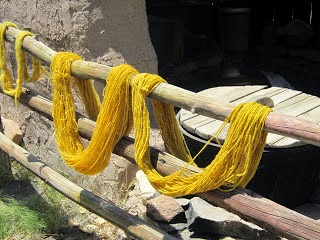During colonial times there often wasn’t enough money to buy clothing or the cloth to make it with. Consequently, the colonists made their own cloth either from the wool of sheep or from flax, a fibrous plant.
Children usually prepared the wool for spinning by removing debris and dung from the wool and then brushing it with “cards” or combs, which were made like large, square hairbrushes with sharp wooden pegs or nails as the bristles.
To prepare flax, they removed the seeds and crushed the stems, removing the outer casing and revealing the part of the plant to be turned into thread.
Colonial women did the spinning, dyeing, and weaving. They spun the wool or flax fibers into thread using a spinning wheel. Once the thread was spun, it was dyed, and then turned into sheets of fabric using a loom. This was called homespun cloth.
 |
|
During Francis Marion Memorial Days at Camp Bob Cooper
near
Mrs. Peggy Chiappetta demonstrates how to dye cloth
with indigo. |
Many different plants and berries were used for dyeing:
blue sunflower seeds, dogwood bark, red cabbage, mulberries (royal purple), elderberries (lavender), grapes (purple) raspberries (purple/blue)
brown acorns (boiled), broom sedge (golden yellow brown), coffee grinds, tea, beet root (dark brown); goldenrod shoots (deep brown), ivy twigs (yellow/brown), juniper berries, pine tree bark, walnut hulls (dark brown), dandelion roots gold coneflower leaves and stems
green sage, spinach leaves (dark olive green), black-eyed Susan, red pine needles, red onion skins, Queen Anne’s Lace (pale green), chamomile leaves
orange alder bark, bloodroot (reddish orange), carrot, barberry (yellow orange) pink wild
red raspberry, strawberries, beets (deep pink), cherries, camilla (pink- magenta)
purple blue berries
red eucalyptus leaves and bark (also makes tan and rust), rose hips, dried hibiscus flowers, crab apple bark, St. John’s Wort whole plant soaked in alcohol, wild ripe blackberries
yellow dandelions, marigolds, rabbitbrush, barberry (yellow orange), butternut tree (light yellow orange), bay leaves, celery leaves, and onions
 |
| picture is from http://missabigailshopechest.blogspot.com |
Plant Fixatives (for plant dyes) 4 parts cold water to 1 part vinegar
To make marigold dye
Things you’ll need:• large pot
• wooden spoon
• rubber gloves (to protect hands from dye)
• potato masher
• colander or sieve for straining
• 2 tbls. vinegar
• 1 quart of water
• 2 cups of marigold petals
• 10 yards of white cotton string or white yarn
Instructions
• Pour the quart of water into the pot and add the marigold petals. Let sit overnight.
• Heat the mixture and let it simmer for 15 minutes
• Remove from heat and mash the petals with the masher
• Return to heat and simmer for another 15 minutes
• Strain and discard the petals
• Roll your string or yarn into a coil or skein and secure with a string to keep it from tangling
• Soak the skein in the pot of yellow dye until desired color intensity (overnight for bright yellow)
• Squeeze out the excess liquid, hang on a stick or peg, and allow the skein to dry
Susan F. Craft's Revolutionary War novel, The Chamomile, won the SIBA Okra Pick Award. She has two post-Revolutionary War novels set for release in 2015 - Laurel, on January 12, and Cassia, on September 14, by Lighthouse Publishing of the Carolinas. She is represented by Linda S. Glaz, Hartline Literary Agency.



Susan: Thanks for sharing. I'm not very familiar with the colonial era. This was fascinating.
ReplyDeleteThank you, Linda. The colonial era has become my favorite. I'm researching the way colonial women had to learn about natural medicines, especially from the Indians. Now that is fascinating.
DeleteI have marigolds growing. I'd love to try dying something. I have in the past, but did not fix the colors.
ReplyDeleteMary, let me know if you try the recipe.
DeleteI love this! I once wrote an article on a guy who made Windsor chairs using only tools from the early 1800s. This time period is so interesting. Thank you for the recipe for dyeing using marigolds.
ReplyDeleteThanks so much, Patricia. I'm glad you enjoyed the post.
ReplyDelete